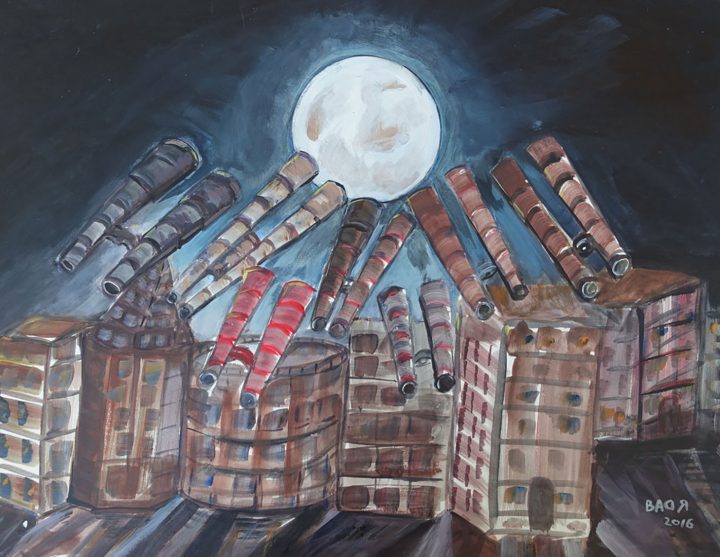|
By Elena Goukassian
From Hyperallergic | Original Article
Critics say the change in policy further dehumanizes prisoners who have been at the center of international controversy since the Guantánamo facility was opened.

Ahmed Rabbani, “Untitled (Binoculars Pointing at the Moon)” (2016), work on paper (all images courtesy Art from Guantánsmo Bay exhibition, and used with permission)
The 41 remaining detainees at Guantanamo Bay just lost ownership to their own artwork — paintings, drawings, and even sculptures created while shackled to the floor. According to Carol Rosenberg at the Miami Herald, the Pentagon has decided to claim ownership of all creative works made inside the detention center, and they may even decide to burn them.
According to Rosenberg, art classes started at Gitmo “in the later years of the Bush administration as commanders explored ways to distract detainees who had spent years in single-cell lockups from getting into clashes with the guards.” The program appeared successful, and even US military personnel were impressed. Detainees began sending works they’d created as presents to their lawyers and families — after close inspection and screening for subliminal messages, of course.

Muhammad Ansi, “Untitled (Hands Holding Flowers through Bars)” (2016), work on paper
Rosenberg’s article sites an ongoing exhibition of Guantanamo artwork at CUNY’s John Jay College of Criminal Justice, Ode to the Sea (which has gotten international media attention), as the impetus to the Pentagon’s latest decision. On the exhibition’s website, there is an email address listed for those interested in purchasing work. Rosenberg cites a Pentagon spokesperson concerned about “where the money for the sales is going.”
Erin Thompson, associate professor of art crime at John Jay College and one of three curators who organized Ode to the Sea, told Hyperallergic that of the eight artists featured in the exhibition, four are former prisoners, and only their work is for sale. Furthermore, no one from the Pentagon even tried to contact her to ask about sales, even though her email address is plainly listed on the site. (Thompson responded to Hyperallergic’s inquiry almost immediately.)

Muhammad Ansi, “Untitled (Crying Eye)” (2016), work on paper
Thompson said that as she was planning the show, she was worried about how it might affect detainees, both current and former, but “this wasn’t the blowback I was expecting. This is just another way to crush the humanity out of detainees,” she said, noting that the purpose of Ode to the Sea is not to absolve prisoners of any potential responsibility. “One of the current detainees in the show has pled guilty,” she said. “It’s always very complicated. We’re just advocating using art as a means of understanding.”

Ammar Al-Baluchi, “Vertigo at Guantanamo” (2016), pencil and watercolor on paper
By the time Hyperallergic talked to Thompson, she had already fielded a number of phone calls, including two from 9/11 widows. “They thanked me,” she said, adding that she was nervous when picking up their calls. “They said they’ve been looking for justice, and anything that brings attention to Guantanamo is a good thing.” Thompson also heard from a few detainee lawyers she’d been working with, one of whom told her they’d use this latest development in hearings to prove human rights abuse at Guantanamo.
Molly Crabapple, a New York-based artist who visited Guantanamo Bay a few years ago, creating an extensive series of drawings for VICE, told Hyperallergic that she’s not at all surprised by the Pentagon’s reaction. “Guantanamo is, among other things, one of the pettiest places on Earth,” she said. “They’re constantly denying prisoners their dignity and even their status as adult humans.” While at Guantanamo Bay, she remembers admiring and complimenting a prisoner’s drawings, which the guard immediately dismissed as just tracings.
“I’m happy that artists are paying attention to Guantánamo,” Thompson concluded at the end of our conversation. “The more, the better.”
Ode to the Sea continues at the President’s Gallery, John Jay College of Criminal Justice (524 West 59th Street, Hell’s Kitchen, Manhattan) through January 26, 2018.
|